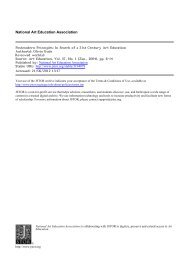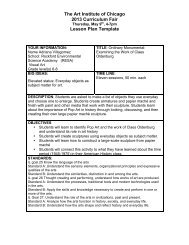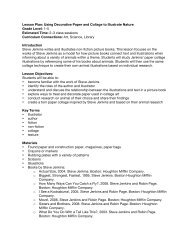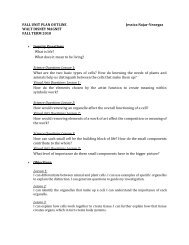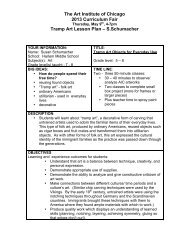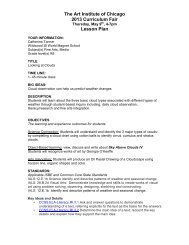Lesson 1 - LearningThroughMuseums
Lesson 1 - LearningThroughMuseums
Lesson 1 - LearningThroughMuseums
You also want an ePaper? Increase the reach of your titles
YUMPU automatically turns print PDFs into web optimized ePapers that Google loves.
English Language Learner Standards<br />
Standard 1 Reading: Arrange information on topics gathered from reading.<br />
Standard 2 Communication: Edit and revise own writing to produce final drafts.<br />
Objectives<br />
• Students will identify and explain the meaning of symbols used in artistic representations of maps.<br />
• Students will compare and contrast two different maps.<br />
• Students will define and use vocabulary in expository writing explaining the use of symbols.<br />
• Students will draw maps of fictional or actual places, using symbols to communicate features.<br />
Background Information<br />
The artwork: Bedcover Entitled “Map”, c.1920<br />
The artist: Unknown. Made in Indiana, United States<br />
Relevant Information:<br />
• Textiles, or objects primarily made of natural or synthetic materials, are all around us—we wear<br />
them as clothes, use them to cushion our chairs, beds and sofas, and even display them as art.<br />
• Bedcover Entitled “Map” illustrates a full-scale map of the United States of America in the early<br />
1900s. If we count the states, we notice that 48 are listed. In addition, Canada, Mexico, and Cuba<br />
are included as well as the Atlantic Ocean, Pacific Ocean, and the Gulf of Mexico.<br />
• When we view this work of art it is clear that we are looking at the United States and its<br />
neighboring countries because we can recognize the shapes that identify the geographic borders of<br />
each state and the entire country. This makes the map accurate, or true to life.<br />
• The artist uses color as a symbol to provide additional information about the map: states’ names<br />
are sewn, or embroidered, in black, while the paths of rivers appear in blue and travel routes are<br />
stitched in brown thread.<br />
• By presenting the map as a bedcover, the artist gives us clues about its potential uses and how art<br />
can be integrated in our everyday lives. Bedcover Entitled “Map” not only offers geographic<br />
information, but it provides warmth and comfort as an everyday object and it showcases the artist’s<br />
skill in the decorative arts.<br />
• It is safe to assume that the person who made Bedcover Entitled “Map” was probably not a<br />
professional cartographer, or a person who makes maps on paper, but someone who used maps as<br />
inspiration. Many artists have used maps as source material, producing both literal interpretations<br />
of place and fantastic scenes of imaginary lands.<br />
The artwork: Hanging Entitled “Map of the Middle West”, 1931<br />
The artist: Unknown. Made in Europe or the United States<br />
Relevant Information:<br />
• The embroidered Hanging Entitled “Map of the Middle West” features the states of the Midwest<br />
region.<br />
Art Institute of Chicago • 107



